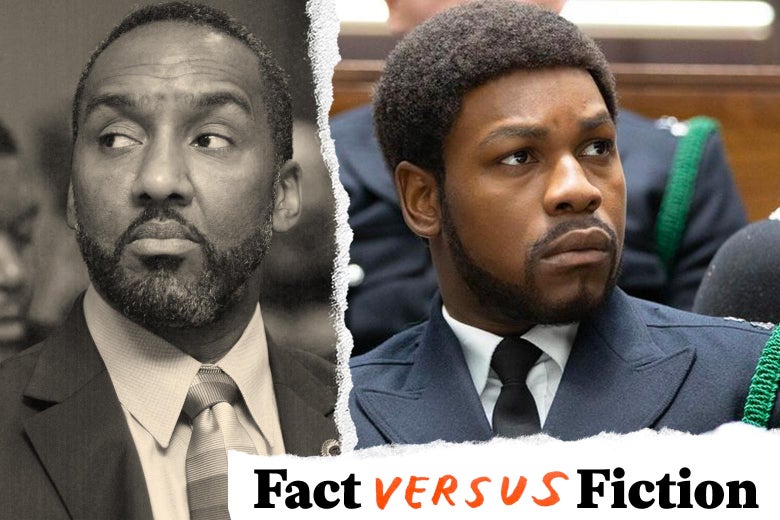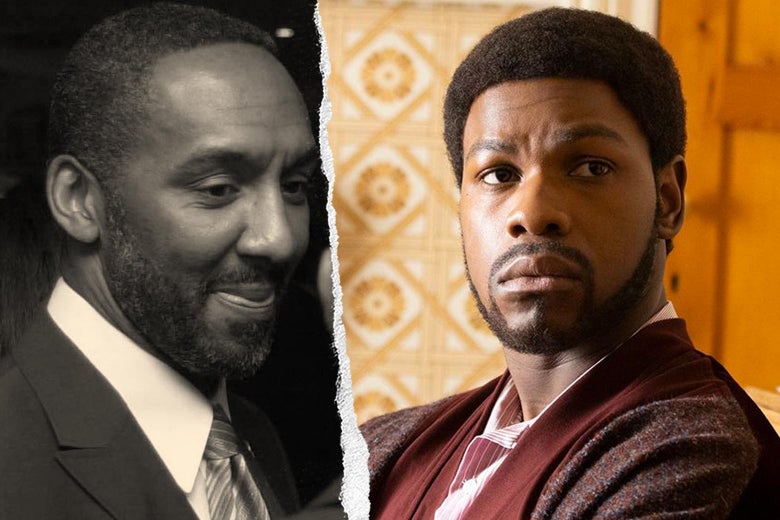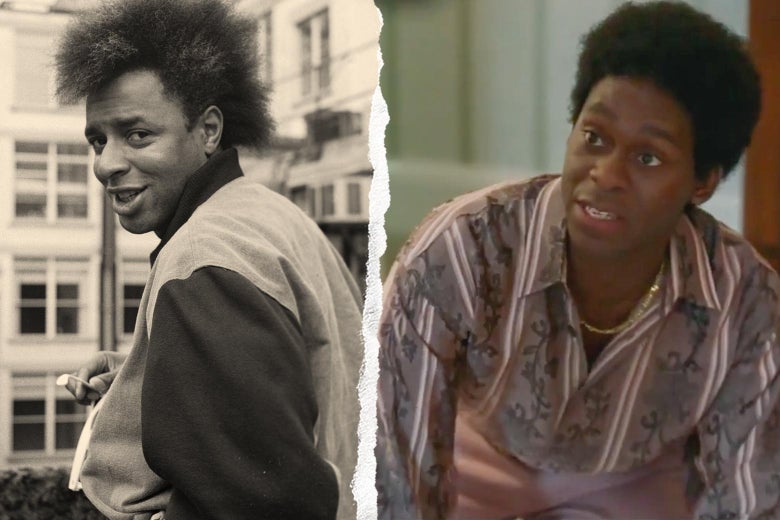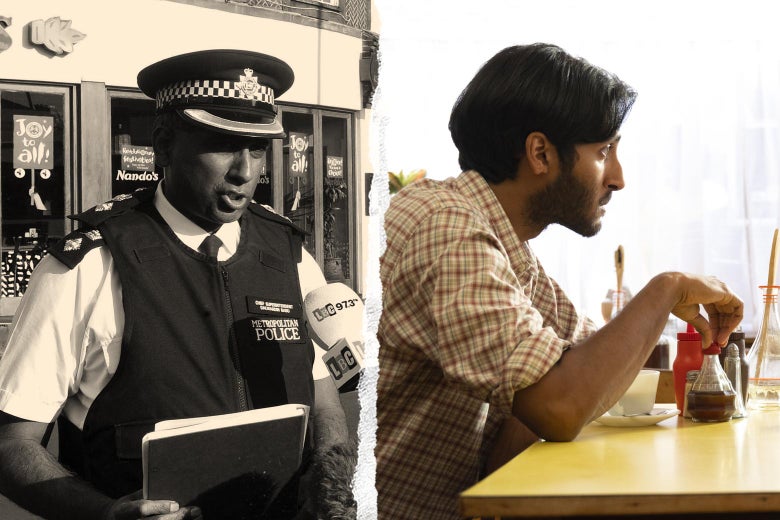
Red, White and Blue, the third film in director Steve McQueen’s Small Axe anthology, takes an insider view of racial injustice within the British criminal justice system. Like the series’ first installment, Mangrove, the Small Axe movies dramatize stories of London’s West Indian immigrant community to show the anti-Black racism that pervaded much of U.K. society throughout the 20th century—and how Black Britons fought back. But where Mangrove shows activists taking on the system from the outside, Red, White and Blue showcases the resistance from within.
The movie follows Leroy Logan (portrayed here by John Boyega), a son of Jamaican immigrants who witnesses the brutal treatment of Black residents at the hands of the Metropolitan Police and decides to join the force himself to improve Scotland Yard’s relationships with Britain’s minority communities. The real Logan, who is still alive today, garnered national attention for helping recruit more officers of color, founding the country’s National Black Police Association, and working on the investigations into the racist murder of Stephen Lawrence as well as the killing of schoolboy Damilola Taylor, both notorious cases for the Met. Though he’s been officially retired since 2013, Logan continues to speak out about racism in the U.K., recently claiming Black Britons’ trust in police is the worst it’s been in decades.
Red, White and Blue primarily covers the early years of Logan’s time on the force, showcasing his joining the Yard, the struggles behind that career decision, and the racist treatment he experienced throughout the way. McQueen strays a little more from the historical record here than he did in Mangrove. Did Logan really apply for the job after the police beat his own father? Did he really answer being called “Judas” by saying “that’s Constable Judas”? We break it down.
Leroy Logan’s Early Life

The first shots of Red, White and Blue show Leroy as a child (Nathan Vidal) standing in front of a school, holding an instrument case and waiting to be picked up. While there, he gets approached by some cops, who frisk him and start looking through his belongings before Leroy’s father, Ken (Steve Toussaint), comes by to yell at the officers for harassing a child. According to Logan’s memoir, Closing Ranks: My Life as a Cop (which was published this year and features a foreword from McQueen), this kind of incident happened “on several occasions” as he left his music practices—and while it certainly made him nervous about the Met, it didn’t stop him from likewise being inspired by the Black cops he’d seen in his home country of Jamaica. The music aspect is significant here for another reason: It was in grade school where he met and became lifelong friends with the to-be-famous singer and bandleader Leee John (Tyrone Huntley). They would end up performing together in their younger years, though Leroy never pursued music as a career.
As depicted in the film, Logan’s first job was as a medical research scientist; he’d wanted to be a doctor from a young age. And he was athletic—though he claims in his memoir he was never “top” at any sports in secondary school—practicing running and boxing throughout his life, as we see on screen.
Joining the Metropolitan Police
Perhaps the most significant difference between Logan’s account of his own life and Red, White and Blue concerns Logan’s ultimate inspiration for joining the Yard. The movie implies that a police assault on his father spurred Logan to join to change British policing. The assault itself did happen, and the movie’s depiction of it is extremely true to the record: Ken, who worked a driving job, parked his truck on the street while getting some lunch at a restaurant, and two cops harassed him for parking where he did, claiming he was obstructing the street. According to Leroy, Ken really did take out a measuring tape to display to the officers that he was allowed to park there and he was not blocking anything, only to end up being beaten up by the cops nonetheless.

Leroy, however, says that in reality he’d already submitted his application to the Yard and was offered a position before his dad was beaten up. He had made friends with some police officers at the sports facilities in the hospital where he worked, and they spoke about good experiences on the job and offered to take him along on rides. Logan’s partner, Gretl (Antonia Thomas), was encouraging, and ultimately it was that support, as well as the childhood influence by Black cops in Jamaica and even the few in the U.K., that drove Logan to consider becoming one himself.
In Closing Ranks, Logan says that his mother did notify him of his father’s attack while at his job, as seen in the film (though Logan writes that he was called personally, not beeped)—and, after seeing his father’s state, that he considered not going through with the process for joining the Met. He was, however, given a push by Leee John’s mother, Jessie Stephens (Nadine Marshall), who worked as a police liaison. As he finally locked himself in for a career in law enforcement, he initially did not tell his parents; his dad, as depicted in Red, White and Blue, found out when cops showed up to his house verifying Logan’s residences, as noted on his application. (Unlike in the movie, Leroy moved out of his father’s house to his own apartment with Gretl after Ken’s assault.) Ken was indeed upset with Leroy, although he did elect to drive his son to his police training.
Logan’s Relationships

As Red, White and Blue shows, Logan’s new career path deeply affected his relationships with friends, family, and Black British communities at large. Although those closest to him ended up supporting his mission, it took a long time to get there and he lost many friends along the way. Gretl continued to stand by Logan and they did have a child after he started training with the Yard.
I could not verify whether Leee John and Logan clashed over the decision as they are seen doing in the movie, though presumably in real life John was OK with his mother working for the Police Community Advisory Group—as he says to Logan in the movie, the key difference was his mom worked with the police, not for them. (At one point in their filmed conversation, John asks Logan if he’s “gonna be a Jedi or something.” Wonder where he got that idea!)
At a dinner scene, John mentions that “Leroy wanted to be in [my] band,” which screen Logan denies, although real-life Logan writes that he did at one point consider becoming a full-time musician during his work with John. (At one point in the film, John is seen singing on the show Top of the Pops, which reportedly did happen.) Logan’s friendship with John also comes into play in a plotline where Logan encounters an almost-carjacker who’s also a musician. He encourages this young man to play with John instead of pursuing a life of crime, only to be rebuffed. (I could not verify whether this was based on actual events.)
After Logan was trained and started working the street beat, Black Britons passing by really would call him “Judas.” His response in the movie is different from how he reacted in real life: Boyega snaps back with “That’s Constable Judas to you,” while in the book, Logan writes that he merely asked, “How did you know that was my middle name?” Despite such frostiness, both screen and real Logan continued to reach out to Britain’s communities of color, and he was noted prominently in the nation for this work.
Racism Within the Metropolitan Police

The cops Logan gets to know in the film are not ripped directly from the pages of Logan’s life but do seem to be at least loosely based on people Logan recalls both fondly and not-so-fondly in Closing Ranks. In Red, White and Blue, Logan becomes friends with a cop of Pakistani descent named Asif Kamali (Assad Zaman), who is often treated harshly by his white colleagues in instances where he leverages his background to speak to other Pakistani Britons, like in a scene where he speaks Urdu to business owners whose place is vandalized with slurs and is told by another officer to “speak English.” Kamali does not appear to have been real, but in his autobiography Logan does mention forming a relationship with a recruit of South Asian descent named Dal Babu. Babu also spent decades on the force trying to diversify and make it more accountable to minority communities, only to retire in frustration in 2013.
Logan did face racist treatment from plenty of other officers on the force, ranging from colleagues using racial slurs to spraying racist graffiti on his locker. (Apparently, while filming the scene where Logan discovers the latter, Boyega did not know the graffiti would be there, and his filmed reaction is one of genuine anger.) Other cops in the film, like TPC David (Conor Lowson) and the leading inspectors are not mentioned by name in Closing Ranks, though they do at least appear in part to have been inspired by officers Logan actually worked with. David likely was based on Tom Kelly, who, like David, had a dorm room near Logan’s while training and was generally kind to him. The inspectors were likely based on the real-life Sgt. Alan Taplin, who ruled Logan’s beat “with an iron hand.”
On the Job
The scene at Logan’s first day of training classes, where he introduces himself and says he’s “not here to make friends” but to bring needed change to the Yard from the inside out, does closely resemble what he says he stated in Closing Ranks: “In class, the instructor asked each one of us why we had decided to join the police. I told him that I wanted to be a public servant, and that it was important that the Met looked like the community it served. I said that I was a team player, but I wasn’t there to make friends; I was there to work effectively.”
After his training, which Logan passes easily, he’s assigned to his home area of Islington, which is where the real Logan got his policing start. He works the street beat, walking around mostly on foot and interacting with various members of the community. The major case and criminal catch he does in the movie, where he tackles a suspect and messes up his back, was based on real events, though they’re slightly embellished and truncated in Red, White and Blue.
In the film, Logan chases a thief, who beats him up but is ultimately caught by Logan in a dramatic tackle that injures Logan’s back. He calls for backup from the force, but none comes, later leading to a tense confrontation in a game room where he yells at the white officers for not helping when he needed it. This is a combination of several different incidents that Logan describes in Closing Ranks. Logan did indeed chase a potential carjacker, tackle him, and bring him to the cops. Logan injured his back in a different incident, though, and while he did once chase a burglar who tried to beat him up, he was with other cops when that particular chase occurred.
The film also edits two significant events: Logan’s rejected promotion and what occurred with the charges brought against his father. In the movie, Logan applies for a promotion, studies, and takes a required exam, only to not pass and thus be looked over for the promotion, a choice he considers to be racially motivated. In his memoir, Logan writes that he did apply for the Criminal Investigation Department but was told he didn’t get chosen because his “face didn’t fit.” When he went for an actual role promotion within the Met, he was encouraged by superiors, took the classes required, and passed. This occurred in the late ’80s, whereas the film only covers the early part of that decade.
As for his father’s case, it only came to the top of the list for civil action seven years after the assault took place. The police did drop charges against Ken and offer a settlement, which he took, although in the film Ken insists on having his day in court.
The Link LonkDecember 05, 2020 at 06:34AM
https://slate.com/culture/2020/12/red-white-blue-movie-john-boyega-steve-mcqueen-true-story-police-racism.html
Red, White and Blue accuracy: fact vs. fiction in Steve McQueen's movie about police reform and racism starring John Boyega. - Slate
https://news.google.com/search?q=Red&hl=en-US&gl=US&ceid=US:en

No comments:
Post a Comment